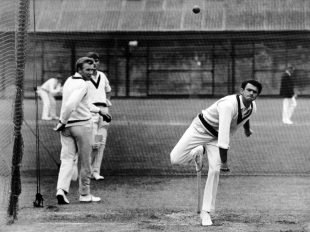John Gleeson

|
|||
|
Related Links
Players/Officials:
John Gleeson
Teams:
Australia
|
|||
GLEESON, JOHN WILLIAM, died on October 8, aged 78. During the 1950-51 Ashes, a 12-year-old boy became fascinated by Jack Iverson's experiments with a table-tennis ball. These had helped him become the feared mystery spinner who confounded England. He flicked the ball out from a folded middle finger, and it turned to leg or off - and often rose sharply - with no discernible change in action. Iverson soon faded from view, undone by a lack of confidence, but young Johnny Gleeson tried to master the trick, while assisting his parents in their general store in Wiangaree, near the foothills of the McPherson Range on the New South Wales-Queensland border.
Gleeson left school at 15, and joined the old Postmaster General's Department as a telephone technician: he spent his working life helping Australians communicate with one another, though his cricket was founded on deception. He started as a wicketkeeper who made a few runs in the lower grades for the Sydney club Western Suburbs, all the while honing those Iverson impersonations in the nets. Quite when Gleeson first delivered a mystery ball in earnest is unclear, but there is no dispute about when they were first widely noticed. Jack Chegwyn, a former NSW batsman, used to take strong sides around the state to give the locals a taste of big cricket. Late in 1965, at Gunnedah - 50 miles west of his home town of Tamworth - Gleeson flummoxed Richie Benaud with an off-break disguised as a leg-break. Benaud immediately organised a place at Sydney's Balmain club, where Gleeson prospered so quickly that he played for NSW in 1966-67.
When they visited Adelaide, he met Don Bradman, who - after facing him in the nets without pads or bat - said: "By the end of the season, I think you'll be playing for Australia." Later that season, Gleeson was picked for what would now be called an A team, in New Zealand, and in December 1967, after only 15 first-class matches, he won the first of his 29 Test caps, against India at Adelaide. Four wickets from 29 eight-ball overs set the tone for his career: at the highest level, Gleeson became a stock bowler whose accuracy allowed batsmen few liberties, while his folded middle finger, from which he flicked out his variations, kept them wary. A Test strike-rate of 95 may sound innocuous, but it should be balanced against an economy-rate of 2.28.
In 1968, he made the first of two trips to England. Memories of Iverson meant batsmen were apprehensive and, although Gleeson never ran through them, he took 12 wickets and kept the runs down. On tour, his polite withdrawals from boisterous night-time activities cemented his nickname of "Cho" - Cricket Hours Only - which had started when he would return to Tamworth after grade games in Sydney. Back home, Gleeson enjoyed his best season in 1968-69. He finished with 50 first-class wickets - only Graham McKenzie and Tony Lock took more - including 26 in five Tests against West Indies, and five for 61, which remained his best figures, to bowl Australia to victory at Melbourne. He also made a Test-best 45 in the final match at Sydney, showing the adhesive technique which had served him well in his early days.
Ashley Mallett - a friend and fellow Test spinner - captured his essence. "In my mind's eye, I can see Cho now," he said. "He moves in with a funny gait, a bit like a comical mix of Groucho Marx and Ronnie Corbett. He's not a short man, but stays low. The delivery doesn't make a fizzing sound, like Prasanna's or Shane Warne's. It glides out of that folded-finger grip, always on target, but devoid of loop or shape."
Gleeson was a man of principle, and never resorted to sledging. In 1969-70, he was one of those who, led by skipper Bill Lawry, spoke up against the Australian administrators' desire to milk another Test out of a team frazzled by the stresses and strains of a 4-0 shellacking in South Africa, straight after five games in India. On the field, Gleeson's bowling kept the South Africans quiet: he teased out 19 wickets, and even Barry Richards had to watch him like a cat. He continued to toil during the dull 1970-71 Ashes, played out on lifeless pitches. He sent down 221 parsimonious eight-ball overs in the first five Tests, before becoming collateral damage when Lawry was axed for the last. Gleeson took a career-best seven for 52 for NSW against Queensland at the SCG in 1971-72, but the following summer in England it became apparent he was an anachronism in the all-action Ian Chappell era, with its emphasis on pace and facial hair. He became a back number behind Mallett, who replaced him in the last two Tests. He finished with 93 Test wickets.
The next season was Gleeson's last at home, although he did tour South Africa again in 1973-74 with the multiracial team organised by Derrick Robins. And he played the following season there for Eastern Province, when his 24 wickets included seven for 73 against Western Province at Newlands. He lived out his retirement in Tamworth, assuring Chappell in his last days: "Don't fret mate, I'm in good shape."

